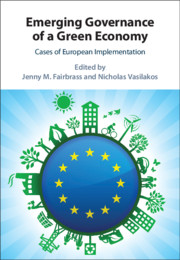Book contents
- Emerging Governance of a Green Economy
- Emerging Governance of a Green Economy
- Copyright page
- Contents
- Figures and Tables
- Contributors
- Preface
- Book Synopsis
- Acknowledgements
- Abbreviations
- 1 The Green Economy
- 2 The Green Economy
- 3 The Green Economy as Good Governance
- 4 On the Verge of a Second Revolution in the European Union’s Utilities Market for Energy Production?
- 5 ‘Great Expectations’
- 6 Overcoming Structural Disadvantages with Local Green Economies?
- 7 Shifting Models of Energy Companies towards Green Economy in Europe
- 8 Carbon Calculation and the Urban Green Economic Opportunity
- 9 The Green Economy
- Index
- References
3 - The Green Economy as Good Governance
The Right Thing to Do?
Published online by Cambridge University Press: 20 January 2021
- Emerging Governance of a Green Economy
- Emerging Governance of a Green Economy
- Copyright page
- Contents
- Figures and Tables
- Contributors
- Preface
- Book Synopsis
- Acknowledgements
- Abbreviations
- 1 The Green Economy
- 2 The Green Economy
- 3 The Green Economy as Good Governance
- 4 On the Verge of a Second Revolution in the European Union’s Utilities Market for Energy Production?
- 5 ‘Great Expectations’
- 6 Overcoming Structural Disadvantages with Local Green Economies?
- 7 Shifting Models of Energy Companies towards Green Economy in Europe
- 8 Carbon Calculation and the Urban Green Economic Opportunity
- 9 The Green Economy
- Index
- References
Summary
In this chapter, we consider the ways in which policy actors may advance the notion of a ‘green economy’ by trying to make it compatible with or equivalent to ‘good governance’. The backdrop to this is that as one possible approach to creating order in advanced industrialised societies, the discourse of governments and non-state actors can be employed to characterise a green economy as 'the right thing to do'. In this way, economic activity can be interlocked with governance arrangements that are also designed to meet environmental objectives. This chapter reflects on current theoretical debates about the idea of a green economy in the European Union (EU), viewing it as a manifestation of good governance, the latter being an umbrella concept that espouses principles of so-called ‘legitimate public policy-making’ such as accountability, transparency, public engagement or institutional reform. In so doing, in this chapter, the discussion encompasses environmental and sustainability policy at the EU and national levels of governance. This line of deliberation reignites an interest in normative power and the ‘will to govern’ as potential forces for governance and sustainability and permits a review of the means though which certain types of economic ordering may be achieved.
- Type
- Chapter
- Information
- Emerging Governance of a Green EconomyCases of European Implementation, pp. 34 - 53Publisher: Cambridge University PressPrint publication year: 2021
References
- 3
- Cited by

